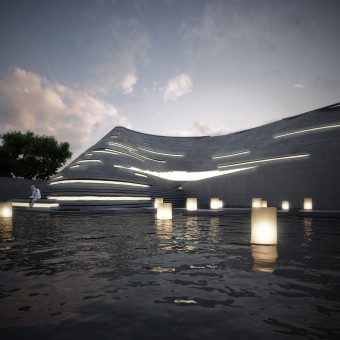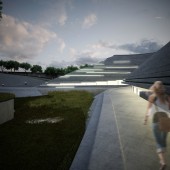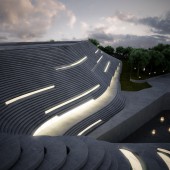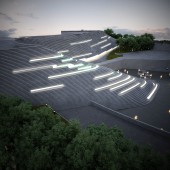
| THE AWARD |
| CATEGORIES |
| REGISTRATION |
| SUBMIT YOUR WORK |
| ENTRY INSTRUCTIONS |
| TERMS & CONDITIONS |
| PUBLICATIONS |
| DATES & FEES |
| METHODOLOGY |
| CONTACT |
| WINNERS |
| PRESS ROOM |
| GET INVOLVED |
| DESIGN PRIZE |
| DESIGN STORE |
| THE AWARD | JURY | CATEGORIES | REGISTRATION | PRESS | WINNERS | PUBLICATIONS | ENTRY INSTRUCTIONS |
Echelon Concert Hall of Damghan by Ghazal Ghozat |
Home > Winners > Design #48005 >Interview |
 |
|
FS: What is the main principle, idea and inspiration behind your design?
GG: Metamorphosis of form and topography and the growth of lines and their height to give birth to the final volume
FS: What has been your main focus in designing this work? Especially what did you want to achieve?
GG: Linking the environment with the space by understanding its own message, in fact, the message conveyed by the architectural platform to objectify it in the design
FS: What are your future plans for this award winning design?
GG: The halls that exist in Iran are not acoustically designed for music performances or symphony orchestras. We hope to be able to realize it in a suitable context.
FS: How long did it take you to design this particular concept?
GG: About 3 months
FS: Why did you design this particular concept? Was this design commissioned or did you decide to pursuit an inspiration?
GG: The design policy of this project It is based on architectural context.
FS: Is your design being produced or used by another company, or do you plan to sell or lease the production rights or do you intent to produce your work yourself?
GG: It is definitely possible to cooperate if there is an employer
FS: What made you design this particular type of work?
GG: Architecture and music have a common feature in placing us in a different sensory space. Therefore, carrying out this project in line with the design of the music performance hall according to the effective parameters of form, volume, age, acoustics, performance, identity, spaces Side became important and necessary
FS: Where there any other designs and/or designers that helped the influence the design of your work?
GG: Alain Provost,London's Thames Barrier Park.
FS: Who is the target customer for his design?
GG: An interaction center and a suitable place for performing and teaching music for those interested
FS: What sets this design apart from other similar or resembling concepts?
GG: Design based on context
FS: How did you come up with the name for this design? What does it mean?
GG: The stepped bed of Badab Surat Damghan made this name fitting
FS: Which design tools did you use when you were working on this project?
GG: Autocad/Rhino/3Dmax
FS: What is the most unique aspect of your design?
GG: Long-form development projects in growth resonance and humble approach to the environment
FS: Who did you collaborate with for this design? Did you work with people with technical / specialized skills?
GG: We benefited a lot from people who are experts in music
FS: What is the role of technology in this particular design?
GG: Detailed design of the shell according to the plan and its use in the external landscape
FS: Is your design influenced by data or analytical research in any way? What kind of research did you conduct for making this design?
GG: First, by using library studies, we analyzed the method of using and analyzing the theoretical foundations of contextualism, then using the method of qualitative analysis of case examples, the principles of contextualized architecture were investigated in the next step by using field studies and observing the site of the intended project. has been And planning to use the principles suitable for the project was suggested.
FS: What are some of the challenges you faced during the design/realization of your concept?
GG: Adapting the outer shell to human comparisons and sizes and not losing the original idea
FS: How did you decide to submit your design to an international design competition?
GG: The appreciation of prominent music and architecture professors for the created design made us participate in the international competition to introduce more designers to contextual architecture.
FS: What did you learn or how did you improve yourself during the designing of this work?
GG: Designing based on the concepts of inclusiveness, integration, coherence, adaptability, flexibility, coexistence, and continuity can achieve a responsive, purposeful and coordinated spatial design.
FS: Thank you for providing us with this opportunity to interview you.
A' Design Award and Competitions grants rights to press members and bloggers to use parts of this interview. This interview is provided as it is; DesignPRWire and A' Design Award and Competitions cannot be held responsible for the answers given by participating designers.
| SOCIAL |
| + Add to Likes / Favorites | Send to My Email | Comment | View Press-Release | Translations |





